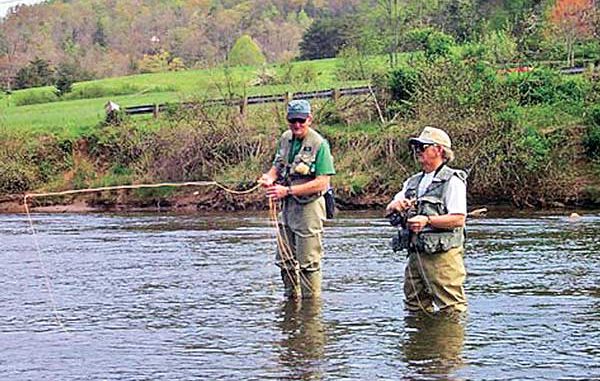
It’s an early weekday evening, and I’m on my way home from work, driving along North River Rd. between Webster and Dillsboro in Jackson County. The Tuckasegee River runs close to the road, and below me, where the river makes a sharp bend and forms a long, wide pool, the surface is dimpled from bank to bank: fish feeding on the evening hatch. It is a sight too tempting to pass.
I stop, get my fly rod, slide down the steep bank, and cast a parachute Pheasant Tail among the dimples. The fly floats lazily without interruption. As I prepare to make another cast, I see a beaver swimming toward me, only its nose and eyes above the surface. When the beaver passes, I place the fly among the dimples, and again, the feeding trout ignore it.
I tie on a yellow mayfly and cast again. This time, I let the fly float until the current drags it under and strip it back in short pulls. I feel a strong tug and pull in a 14-inch brook trout. It is fat-bodied, like a small football. Three more casts, three more brookies. I have my fix for the day.
For years, I ignored the Tuckasegee River, choosing instead to drive to more distant, more pristine streams. Now, it’s one of my favorites. It is not a perfect trout stream by any stretch. Its banks often are littered, and after a heavy rain, the water is the color of chocolate milk. In some areas, I’ve sunk up to my knees in thick, foul-smelling muck.
Despite its flaws, the Tuckasegee is an amazing river. I drive along its banks every morning and see blue herons. A couple of weeks ago, I saw an osprey dive from a tree, hitting the water like a pelican and flying off with a trout clutched in its talons. Some friends who live on the river spotted a bald eagle earlier this spring. If the river is good enough for eagles, osprey, and herons, it’s certainly good enough for me.
The delayed-harvest section of the river between N.C. 107 and the dam in Dillsboro (5½ miles) is the most-heavily stocked stream in the delayed-harvest program. In March, April and May — and again in October and November — the N.C. Wildlife Resources Commission puts at least 49,000 rainbow, brook and brown trout in the river.
Because of the high numbers of fish, the delayed-harvest section is one of the most heavily-fished streams in the area. On weekends, just about every pull-off on North and South River Rds. is lined with cars, most of them with out-of-state tags. Fishing guides can almost guarantee that a client will catch trout in the delayed-harvest section.
The Tuckasegee runs the entire length of Jackson County and is formed by the junction of Panthertown and Greenland creeks in southeastern Jackson, flowing northwest into Swain County where it enters the Little Tennessee River.
The headwaters in Panthertown Valley contain wild brook trout. This part of the river is catch-and-release waters, artificial lures only. Below Cedar Cliff Lake in central Jackson County, the Tuckasegee is joined by the West Fork. This part of the river is hatchery-supported waters, but it often yields a good number of wild brown and rainbow trout. The section of the river at East Laport, a popular picnic and recreation area on NC 107 above Western Carolina University, produced a 15-pound brown trout that stayed on the record books for several years.
Below Dillsboro Dam and continuing to Bryson City in Swain County, the fishery changes to a mix of brown and rainbow trout and smallmouth bass, a section that some area bass fishermen call “premier smallmouth territory.” The lower section also has a good population of bream, and from Ela to Bryson City, walleye often populate the stream, especially during the spawning season.
Maybe I like fishing the Tuckasegee because it’s so convenient. I can fish it on my way home from work. I could fish it on my lunch hour if I wanted to. I can be on the stream 10 minutes after leaving my house. I can catch fish to eat (as long as they’re above the delayed-harvest section) or catch and release as many fish as I care to catch. Even after the bait fishermen take untold numbers of trout from the stream when the delayed-harvest section reverts to catch-and-keep rules, I can still catch trout, even during the hottest months of summer. The numbers aren’t as great, but the trout are there.
It is a good river, and it needs more respect. Unfortunately, the people who use it most, the fishers, are the ones who abuse it the most. Still, the river endures, as it always has, and as it always will.




Be the first to comment